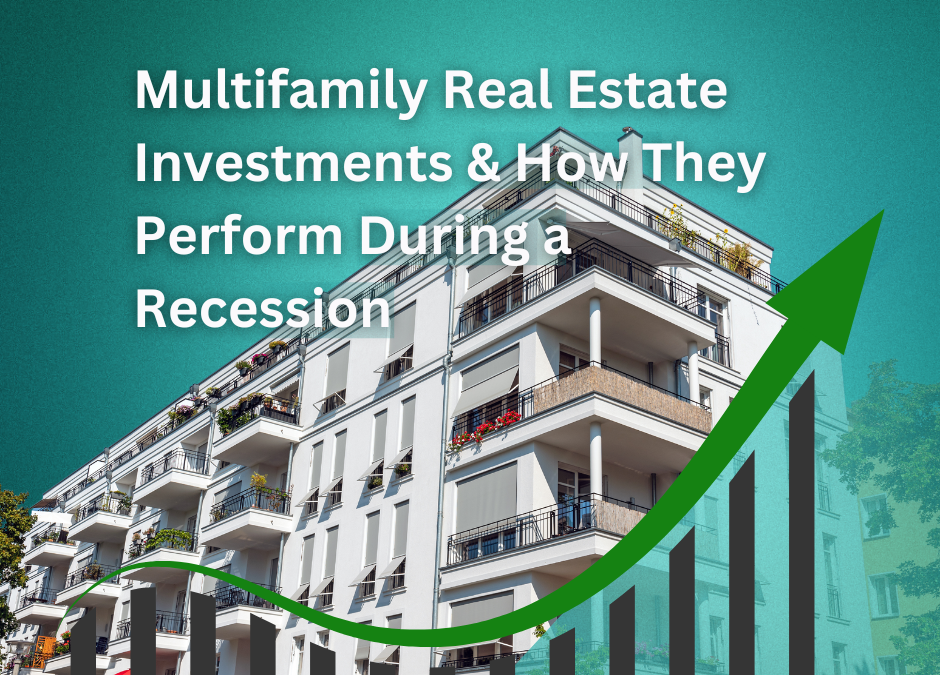One of the most reliable, recession-resistant moves a real estate investor can make is in multifamily property. Multifamily properties outperforms other types of commercial real estate simply because it serves a basic human need – people need somewhere to live. In this article, you will learn how multifamily real estate Investments’ perform during a recession.
We provide solutions to people’s needs as multifamily investors.
However, In real estate, there have been challenges. In past recessions, we have experienced high demand for multifamily real estate while also facing simultaneously increased costs to own and manage those apartment buildings properly.
Any time prices rise dramatically, that influences the US economy, affecting the stock market, property values, costs of consumer goods, interest rates, and other economic conditions. During the Great Recession of ’08-’09, the financial system and the economy waivered. Many investors’ confidence also faltered.
Fast forward to today, and we’ve been hearing about a potential recession for months. This is all while the stock market has experienced volatility and housing prices (single-family homes and multifamily units alike) have skyrocketed. The economic impact of high inflation can be felt in almost every industry,
How Multifamily Real Estate Investments’ Perform During a Recession
Again, only the most recession-resistant investments will fare well as the economy fluctuates and markets seem unpredictable. This is why, even in the best of times, we only consider commercial real estate opportunities with built-in protections like good population growth in the area. One type of commercial real estate investment that tends to fare well during the most uncertain times is multifamily investment properties.
Multifamily Investing Versus Other Commercial Real Estate
During this time of uncertainty, investors are turning to commercial real estate since it’s one of the most stable, tangible investments available. There’s been a dramatic shift of real estate investors toward multifamily buildings. This is because this particular asset class provides a combination of cash flow, appreciation, and tax benefits. This includes times of rising interest rates and an unsettling economic outlook.
Within multifamily investments, you’ll find a wide array of asset classes. This is ranging from class A newly built apartments to class B and C workforce housing.
Other commercial real estate property types available to investors include office buildings, retail, self-storage, and even parking lots and garages. However, if you consider what usually happens during a recession – job losses and reduced or lost incomes – retail sales typically plummet. In addition, we are all dealing with the aftermath of the recent COVID Pandemic. People are embracing technology to efficiently conduct business from their homes, resulting in rare trips to the office, drastically reducing the demand for parking and office space.
So, it’s important to consider consumer behavior and basic human needs while searching for an investment opportunity with a potential recession looming.
With historically low vacancy rates and high demand for affordable housing in multifamily property and apartments nationwide, industry experts are seeing rent growth in multifamily assets. This is even despite the threat of an upcoming recession. Here’s why:
Why Multifamily Real Estate Will Continue To Provide Excellent Cash Flow
Areas with population growth make prime locations for multifamily investing since new and existing tenants alike require a safe, comfortable, and affordable place to live.
Multifamily investors look for areas that have positive labor statistics, strong fundamentals, and great neighborhoods. When these fundamental market factors are met, multifamily investments will see consistent passive cash flow for the unforeseeable future.
Why does multifamily investing continuously have great returns on investment even during a recession? Simply put, people tend to be more frugal during a recession. They spend less, travel less, and do less overall, but still require a place to call home.
Some people choose to downsize or sell their expensive homes in exchange for something more affordable. Others may reduce their monthly expenses by moving out of a fancier, class A suite and into a remodeled (still very nice) class B apartment. This illuminates the consistent demand cycle as tenants move between multifamily asset classes based on their income, lifestyle, and the economy.
During a recession, people who struggle to qualify to purchase a home become reliant on the multifamily market for shelter. In turn, the demand for multifamily rentals remains constant, even if it varies by class.
Why Investments In Different Asset Classes Are A Smart Decision
It’s always a smart move to have a diversified portfolio. This is still true even if your syndication preference is in multifamily investing. It’s ideal to vary your portfolio within the multifamily investment sector with passive deals in different asset classes and markets.
During a recession, certain markets across the country may be more deeply affected by rising prices and experience a lower vacancy rate as a result. On the other hand, certain markets may experience a boom as the local economy benefits from federal reserve decisions. This is depending on the businesses in the area.
Along the same lines, renters may choose to move up or down in asset class within the multifamily space. It depends on their budgets and employment situations.
This doesn’t mean that all Class A apartment buildings will experience low vacancy rates during a recession, as there will always be people demanding higher-profile spaces with the trendiest finishes, no matter the economic conditions.
Recession or not, we have a housing shortage on our hands. New construction (class A) multifamily complexes are continuously trying to keep up with the demand for housing. Yet, during these times when inflation is high, new construction costs increase, slowing the completion process of these multifamily properties. This, in turn, keeps the demand for housing high, subsequently keeping rents high as well.
This means that having a diverse investment portfolio in multiple multifamily asset classes will help ensure that your cash flow remains consistent.
How Do Rental Rates Perform In A Recession?
The multifamily real estate market has historically thrived during economic downturns, and this year is no exception. When people are threatened with financial strain, they tend to cut back on non-necessities rather than face the possibility of becoming homeless.
While the housing market usually takes a hit during a recession, the rental market tends to outperform other investments. Historically, apartment rental rates remain steady or even increase during a recession, while single-family home prices drop.
This is because the demand for housing still exists, but the rising interest rates and pinched budgets push consumers toward a more affordable rental property type. Consumers generally pull back during recessionary times and choose to wait for a market correction before purchasing their own homes.
Multifamily Properties’ Bottom Line
Take note, no matter the looming economic storms or increased costs we face, the basic need for housing will always be present. This is why the multifamily investing is a recession-proof investment.
There are always risks involved in any investment choice, even if you knew for certain we were facing a bull market. Unfortunately, despite the crazy inflation rates, multifamily investing always poses potential opportunities for savvy investors.
When selected strategically in areas of rich population and job growth, multifamily properties have exhibited solid performance over the long haul and have a proven track record for stability.
Summary
Are we in a recession? Some say, “Yes”. Some say, “No”. Some say, “It’s coming”. Either way, apartments, or multifamily investments, outperform other asset classes during a recession.
Why does multifamily fare so well in a recession? For starters, it provides a basic human need – shelter. It also provides housing for potential home buyers that either can’t qualify for a loan or can’t afford a single family house right now. Some families, who can still buy, are choosing to wait to out and see if the market “corrects” before they buy. During that waiting period, they rent! People may cut back on a lot of expenses during a recession but they still need a place to live.
This particular asset class provides a combination of cash flow, appreciation, and tax benefits. During a recession, rents often stabilize or increase.
Does that mean any apartment is a good investment? No! You have to do your homework and invest in an asset in a favorable market. We often look at migration patterns and labor statistics when evaluating a market. You want to invest where people are moving!
As with any type of investing, it’s always smart to have a diversified portfolio. This is through investing in different classes with multifamly investments. Class A investments are newer construction and/or luxury apartments. Class B is more middle class. Class C is often lower income and/or workforce housing. Families often cycle through various classes of apartments depending on their financial situation.
From any point of view, the fact is, we have a housing shortage. And multifamily assets are part of the solution. The multifamily real estate market has historically thrived during turbulent economic times. Remember, apartment rents typically stabilize or increase during a recession, while single-family home prices drop. While the housing market (single family and/or residential properties) usually takes a hit during a recession, the rental market tends to outperform other investments.
When investing in areas where we see population and job growth, multifamily assets have performed very well over the long term.
Finding And Funding Your Next (or First) Syndication Deal
To invest in a real estate syndication,you often have to be an accredited investor. However, a handful of our syndication deals have been available to sophisticated investors over the past year.
In other words, you can take advantage of this wealth building tool at almost any level!
All you have to do is join the Ohana Investor Club which includes a quick call with me to discuss your investing goals, what you’re looking for and how you see real estate syndications moving you toward the lifestyle you desire and deserve. Then, and only then, can I share all of our upcoming offerings with you! We look forward to walking through this investing journey with you!

